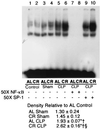Effects of calorie restriction on polymicrobial peritonitis induced by cecum ligation and puncture in young C57BL/6 mice
- PMID: 11527818
- PMCID: PMC96186
- DOI: 10.1128/CDLI.8.5.1003-1011.2001
Effects of calorie restriction on polymicrobial peritonitis induced by cecum ligation and puncture in young C57BL/6 mice
Abstract
Calorie restriction (CR) is known to prolong the life span and maintain an active immune function in aged mice, but it is still not known if rodents under CR can respond optimally to bacterial infection. We report here on the influence of CR on the response of peritoneal macrophages to lipopolysaccharide, splenic NF-kappaB and NF-interleukin-6 (IL-6) activities, and mortality in polymicrobial sepsis induced by cecal ligation and puncture (CLP). Macrophages from 6-month-old C57BL/6 mice on a calorie-restricted diet were less responsive to lipopolysaccharide, as evidenced by lower levels of IL-12 and IL-6 protein and mRNA expression. Furthermore, in vitro lipopolysaccharide-stimulated macrophages from mice under CR also expressed decreased lipopolysaccharide receptor CD14 levels as well as Toll-like receptor 2 (TLR2) and TLR4 mRNA levels. In addition, the phagocytic capacity and class II (I-A(b)) expression of macrophages were also found to be significantly lower in mice under CR. Mice under CR died earlier (P < 0.005) after sepsis induced by CLP, which appeared to be a result of increased levels in serum of the proinflammatory cytokines tumor necrosis factor alpha and IL-6 and splenic NF-kappaB and NF-IL-6 activation 4 h after CLP. However, mice under CR survived significantly (P < 0.005) longer than mice fed ad libitum when injected with paraquat, a free radical-inducing agent. These data suggest that young mice under CR may be protected against oxidative stress but may have delayed maturation of macrophage function and increased susceptibility to bacterial infection.
Figures










References
-
- Avula C P, Fernandes G. Modulation of antioxidant enzymes and apoptosis in mice by dietary lipids and treadmill exercise. J Clin Immunol. 1999;19:35–44. - PubMed
-
- Ayala A, Deol Z K, Lehman D L, Herdon C D, Chaudry I H. Does endotoxin play a major role in inducing the depression of macrophage function during polymicrobial sepsis? Arch Surg. 1995;130:1178–1184. (discussion, 1184–1185). - PubMed
-
- Ayala A, O'Neill P J, Uebele S A, Herdon C D, Chaudry I H. Mechanism of splenic immunosuppression during sepsis: key role of Kupffer cell mediators. J Trauma. 1997;42:882–888. - PubMed
-
- Ayala A, Perrin M M, Kisala J M, Ertel W, Chaudry I H. Polymicrobial sepsis selectively activates peritoneal but not alveolar macrophages to release inflammatory mediators (interleukins-1 and -6 and tumor necrosis factor) Circ Shock. 1992;36:191–199. - PubMed
-
- Ayala A, Perrin M M, Wang P, Ertel W, Chaudry I H. Hemorrhage induces enhanced Kupffer cell cytotoxicity while decreasing peritoneal or splenic macrophage capacity. Involvement of cell-associated tumor necrosis factor and reactive nitrogen. J Immunol. 1991;147:4147–4154. - PubMed
Publication types
MeSH terms
Substances
Grants and funding
LinkOut - more resources
Full Text Sources
Medical
Research Materials
Miscellaneous

